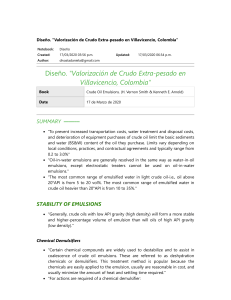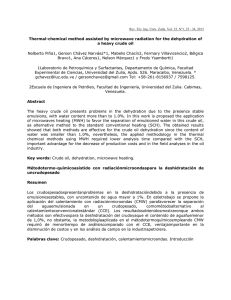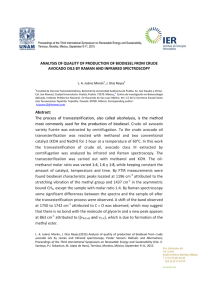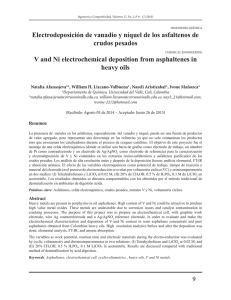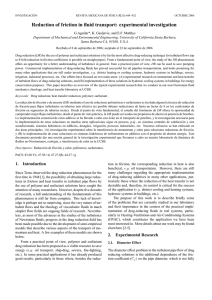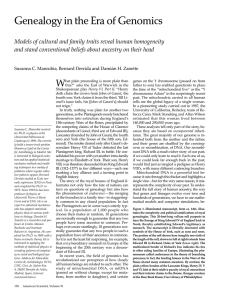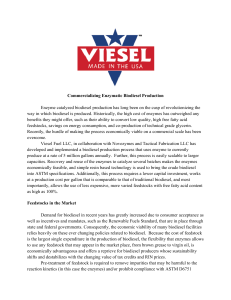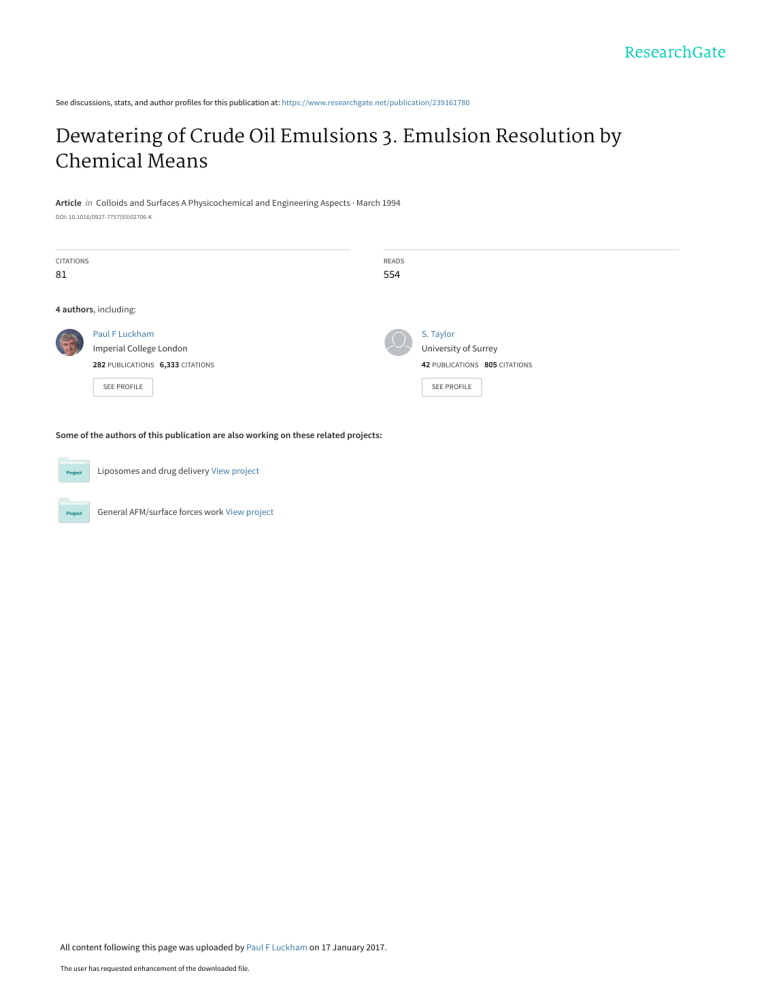
See discussions, stats, and author profiles for this publication at: https://www.researchgate.net/publication/239161780
Dewatering of Crude Oil Emulsions 3. Emulsion Resolution by
Chemical Means
Article in Colloids and Surfaces A Physicochemical and Engineering Aspects · March 1994
DOI: 10.1016/0927-7757(93)02706-K
CITATIONS
READS
81
554
4 authors, including:
Paul F Luckham
S. Taylor
Imperial College London
University of Surrey
282 PUBLICATIONS 6,333 CITATIONS
42 PUBLICATIONS 805 CITATIONS
SEE PROFILE
Some of the authors of this publication are also working on these related projects:
Liposomes and drug delivery View project
General AFM/surface forces work View project
All content following this page was uploaded by Paul F Luckham on 17 January 2017.
The user has requested enhancement of the downloaded file.
SEE PROFILE
Colloids and Surfaces
A: Physicochemical
0927-7757/94/$07.00
0 1994 -
and Engineering
Aspects,
83 (1994)
261-271
261
Elsevier Science B.V. All rights reserved.
Dewatering of crude oil emulsions
3. Emulsion resolution by chemical means
R.A. Mohammeda”,
A.I. Bailey”,*, P.F. Luckham”,
S.E. Taylorb
aDepartment of Chemical Engineering and Chemical Technology, Imperial College of Science, Technology and
Medicine, Prince Consort Road, London SW7 2BY, UK
bSurface and Colloid Science Group, BP Group Research and Engineering Centre, Chertsey Road,
Sunbury-on- Thames, Middlesex, T WI 6 7LN, UK
(Received
15 July 1993; accepted
5 November
1993)
Abstract
In Parts 1 and 2 of this series of papers, the importance
of interfacial properties in determining the stability of waterin-Buchan
crude oil emulsions has been demonstrated.
In this third part of the series, we report on the chemical
demulsification
of water-in-crude
oil emulsions. Two classes of experiment
were carried out; bottle tests in which
emulsion resolution
was followed by the appearance
of a separated
aqueous layer in the bottom of the tube, and
microscopic
examinations,
where resolution
was directly
followed
by observing
coalescence
of the droplets.
Demulsification
was achieved by adding one of the commercial
demulsifiers Unideml20
and BJl8. Unideml20
is a
blend of non-ionic and anionic surfactants,
whereas BJ18 was specially developed for the demulsification
of Buchan
crude. Some of the pure constituents
of these blended surfactants
were also used for resolving water-in-Buchan
crude
oil emulsions. Two types of behaviour
were observed: type I behaviour,
showing constant
water separation
with
increased
demulsifier
concentration,
and type II, showing reduced water separation
with increased
demulsifier
concentration.
To a small extent, there exists a degree of functional
specificity in the demulsifier molecules towards
interaction
with the constituents
of the interfacial film, and to a larger extent good emulsion resolution is governed by
the interfacial properties of the demulsifier blend.
Key words: Chemical
demulsification;
Crude oil emulsion;
Dewatering;
Introduction
The destabilisation
of water-in-crude
oil emulsions is an important
process in the oil industry
[l-3].
During production,
it is essential to remove
water from crude oil in order to reduce corrosion
of pipelines and hence optimise their usage. In
refinery operations,
potentially
corrosive salts are
removed from the crude by deliberate emulsification of fresh (wash) water to produce 5-10% waterin-crude
oil emulsions,
which are subsequently
*Corresponding
author.
address:
Drilling
Fluids
Group,
Production
‘Present
Department,
Intevep,
S.A., Apdo. 76343, Caracas
1070-A,
Venezuela.
SSDI
0927-7757(93)02706-K
Emulsion
resolution
with added
broken using electrical dehydrators
[ 21. Various chemicals
demulsifying
chemicals
have been used as demulsifiers, such as non-ionic
surfactants
based on ethylene
and propylene
oxides [ 2,4].
The investigation
of the kinetics of the chemical
demulsification
process is complicated by the interaction of three main effects [2]. These are (1) the
displacement
of the asphaltic
film from the
water/oil interface by the demulsifier, (2) flocculation, and (3) coalescence of water drops.
The predominant
rate-determining
step is
decided by the nature of the emulsion,
and the
stage which breaking has reached at any moment.
Lawrence and Killner [S] referred to the concen-
262
R.A. Mohammed et al./Colloids Surfaces A: Physicochem. Eng. Aspects 83 (1994)
tration levels of the added demulsifier
and concluded that their values should not greatly exceed
the critical micelle concentration
(CMC), suggesting that demulsifier action may be in part due to
solubilisation
of the asphaltic material.
Little [6] described successful demulsifiers to be
very poor emulsifiers,
and stated that chemical
demulsification
is dependent
on the collision rate
between droplet particles after the demulsifier has
been thoroughly
mixed.
Graham et al. [7] referred to the importance
of
the type of solvent on the demulsification
process.
By using bottle tests, these investigators
identified
two different water separation profiles of water-inForties crude oil emulsions, an immediate emulsion
resolution and an inductive resolution where water
separation
occurred after a period of time. The
former occurred, for example, when the demulsifier
was added to the emulsion
without the solvent
carrier, whereas
the latter occurred
when the
demulsifier
was mixed with the carrier solvent
before introduction
into the emulsion.
Aveyard et al. [S] studied the kinetics of demulsification by considering
two types of “low molar
mass” demulsifier,
a non-ionic
and an anionic
surfactant,
in order to study their effects on the
rate of resolving water-in-Forties
crude oil emulsions. The demulsification
rate increased with surfactant concentration
up to the onset of surfactant
aggregation either in the bulk phases, or in a third
surfactant-rich
phase. However, higher surfactant
concentrations
produced either a lower demulsification rate, or a slight increase to a plateau.
Sjoblom et al. [9] conducted
a destabilisation
study on water-in-Norwegian
crude oil emulsions
using medium chain alcohols and amines. They
demonstrated
that these chemicals speed up the
separation
of water from water-in-crude
oil emulsions. These authors
concluded
that alcohols
modify the rigidity of the interfacial
film by a
diffusion/partitioning
process, while amines show
a strong and specific interaction
with the interfacial
groups constituting
the film formed between water
and crude oil. These specific interactions
render
the interfacial film more hydrophilic.
Among other methods of resolving emulsions of
261-271
the water-in-crude
oil type is electrical dehydration
which will be discussed in detail in the next part
of this series. Centrifuging
stable emulsions often
results in the separation
of a concentrated
waterin-oil emulsion, which does not break the protective film surrounding
the water drops. However,
elevation of temperature
has several useful effects.
It reduces the viscosity of the external oil phase,
increases the difference in density of the phases,
increases the chances of droplet collision, and it
usually weakens the stabilising film.
To date, rigorous studies to examine demulsification rates of crude oil emulsions
have been
hindered by many factors, such as the opacity of
the crude and the variation
in composition.
A
method claimed to be promising is based on electroacoustics
[ 10,111, since it is not affected by the
opacity of the crude in order to obtain information
on the demulsification
rates. One would anticipate
that the success of this method will depend on the
type of emulsion being examined. The application
of this method to monitor the coagulation
of oilin-water emulsions would be expected to be successful since double layer effects exist. This method
has been used by Isaacs and co-workers [ 10,111
to study the coagulation
of water-in-crude
oil
emulsions following their treatment with chemical
demulsifiers.
In a previous publication
in this series [ 121, we
have reported on the effectiveness of two chemical
demulsifiers
in destabilising
the asphaltene
films
formed at the oil/water interface by studying the
rheological
properties
of the interfacial films. In
this paper, we study the effect of these materials
on the resolution of water-in-crude
oil emulsions.
Furthermore,
since the commercial materials tend
to be blends of surfactant designed to give optimum
performance,
we have also studied the resolving
power of single surfactants in the blend.
Experimental
Materials
The crude oil was from the Buchan oil field and
was used as supplied. The demulsifiers applied to
R.A. Mohammed et al./Colloids
Surfaces A: Physicochem.
Eng. Aspects 83 (1994)
263
261-271
resolve Buchan crude emulsions were from Grace
Dearborne
plc. These surfactants
are of the non-
in length and 2 in in diameter at room temperature. Water-in-Buchan
crude oil emulsions (10%)
ionic type, Pluronic (PE) and Tetronic (T) series,
containing
different
amounts
of poly(ethylene
were prepared
in a glass container
which was
inverted a number
of times to ensure that the
oxide)
(PEO)
and
poly(propylene
oxide)
contents
(PPO)
were uniformly
distributed
before filling
groups (shown in Fig. 1). Table 1 presents
the
average
molecular
weights
together
with the
number of PEO and PPO units in each demulsifier
up the tubes. The appropriate
demulsifier
was
delivered
using a microsyringe,
followed by a
careful inversion of the tubes in order to disperse
used and the calculated
the demulsifier.
The height of the separated
was
as a function
ance (HLB)
number.
hydrophile-lipophile
The demulsifier
bal-
D112 is the
EOY
\
PO,-EOY
Ii
PO,-EOY
H
/
N -CH2-
CH2-N
/
of time,
water
until
no
further change occurred.
Chemical demulsification
was examined using a
microscope stage cell based on a design by Taylor
[ 33. This cell enabled chemical demulsification
to
be monitored
using a video camera fitted to the
microscope.
surfactant
octylphenol-formaldehyde
condensate
with PO + EO. IL2 is dodecylbenzenesulphonic
acid (DBS), a wetting agent. Unidem120 is a blend
of T1301, IL2, D112, and DW12, and BJ18 is a
complex EO/PO based on a polyfunctional
amine.
Bottle tests were conducted
in glass tubes 3 in
H EOY40,
recorded
60
I x
0
H
EOY
H
EO
Y
PO
I x
0
PO
I x
0
H
EO
Y
60
I x
0
H
\
H EOY-POX
(B)
H
EOyH
E”Y
d
d
90 3H
,‘I
0
d12
C9H 19
H
25
m=S-8
w
(D)
Fig. 1. The structure
of the demulsifiers
used in this study: (A) the structure
of the tetronics series; (B) the demulsifier DI12,
octylphenol-formaldehyde
condensate + PO + EO; (C) the demulsifier DW12, nonylphenol-formaldehyde
condensate + PO + EO;
(D) dodecylbenzenesulphonic
acid.
R.A. Mohammed et al./Colloids Surfaces A: Physicochem. Eng. Aspects 83 ( 1994 ) 261-271
264
Table 1
The average molecular weight of the commercial
different demulsifier components
demulsifier
components
together
with the number
of PEO and PPO
Surfactant
No.
average
mol. wt.
PPO
mol. wt.
No.
of PPO
units (x)
PEO
mol. wt.
No. of
PEO units (y)
HLB,,,,
T701
T803
T1301
T1302
T1501
PE6200
PE6400
DIl2”
DW12b
3700
5000
6900
7400
7900
2500
3000
4000
3000
3300
3500
6000
6000
7100
2000
1800
1740
None
15
15
25
25
30
34
31
7.5
370
1500
700
1400
800
500
1200
1400
1300
1.5
8.5
4.0
8.0
4.5
11
27
8.0
3.5
5.3
7.6
4.6
5.9
4.0
9.1
5.8
“Average
bAverage
molecular
molecular
weight of octylphenolLHCH0
weight of nonylphenolkHCH0,
units of the
resin, 500.
1700.
Results
Bottle test
Results from such tests indicate the suitability
of using a particular surfactant as a demulsifier in
terms of quality and quantity of water separation
in the oilfield.
The time taken for the first appearance
of separated water was recorded. A profile of percentage
volume of water separated
at different concentration levels of added demulsifier was then constructed. Good resolution
corresponds
in general
to a mirror-like
sharp interface.
Addition of Unideml20
The demulsifier blend
Unidem120,
when added
to the emulsion
in the concentration
range
1000-20 000 ppm at room temperature,
produced
murky water. The amount of water settled increases
with demulsifier
concentration
until a plateau is
reached
(Fig. 2). This behaviour
is designated
type I as opposed to type II (see later). Earlier
trials
using
a
lower
concentration
range
(lo-50 ppm) produced very little separation. In the
oilfield, these demulsifiers
are added at stream
temperatures
of about 40°C and at a very low
concentration
(l-5 ppm). Both heat and electrical
.
Fig. 2. The resolution of 10% water-in-Buchan
crude emulsion
by Unideml20
in the concentration
range 1000-20000 ppm at
room temperature.
treatment
will then help to resolve the emulsion.
The interface shown in the figure appears to be
sharp and well defined; large drops of water had
completely coalesced and separated.
Addition of components of Unideml20
When a component
of Unidem120,
T1301 was
added, there was an increase in water separation
with concentration.
Initially at 50 ppm, 15% water
separation
was achieved. A maximum
resolution
of 38% water separation was achieved at an optimum concentration
of 700 ppm, beyond which
R.A. Mohammed et al./ColEoids Surfaces A: Physicochem. Eng. Aspects 83 (1994 j 261-271
(above
dropped
1000 ppm) the level of separated
to a constant
water had
value of 21% as shown
in
265
be clean. Similar water appearances were observed
when the components
D112 and DW12 were
Fig. 3. This behaviour
is designated
as type II
behaviour.
In the concentration
range within the
overdosing region (i.e. above 1000 ppm) the water
applied.
appeared
Addition of BJ18
The demulsifier BJ18, when added to the emulsion, produced an interface which appeared to be
to be clean, and a phase rich in surfactant
was observed at the bottom of the tube.
When IL2 was added at 70 ppm, 5% water
separated. An increase to about 37% in water level
was observed when the demulsifier concentration
was increased
to 800 ppm. Above this concentration, the water level had reached a plateau as
shown in Fig. 4. The separated water appeared to
10
’
0
I
I
1000
I
I
2000
3000
4000
5000
~1301concentration ppm
6000
7000
Fig. 3. Plot of percentage volume of water separated from 10%
water-in-Buchan
crude emulsion
vs. T1301 concentration
in ppm at room temperature.
The continuous
line connects the
experimental
data.
0
’
0
I
500
I
,
I
I
1000
1500
2000
2500
IL2 concentration ppm
I
3000
The separation
profiles
for these surfac-
tants were of type I.
blurred
as shown in Fig. 5. This was because
large
unresolved water drops in the bulk of the emulsion
had rested on the interface. BJ18 has been formulated especially for resolving Buchan crude emulsions. Overdosing
due to excessive levels of added
BJ18 is apparent
in the sharp decrease in the
amount of water separated as shown in the figure.
A plot of the percentage water separated vs. BJ18
concentration
is presented in Fig. 6. A maximum
level of water separation
of about
46% was
observed, this separation
corresponding
to a concentration
of 1500 ppm. The separation
decreases
to zero at 6000 ppm, conforming to type II behaviour. Each test was repeated twice and the average
value of the percentage
of separated
water was
recorded.
Addition of other single surfactants
The surfactants T701 and T803, whose composition is presented in Table 1, were also tested as
demulsifiers
for water-in-Buchan
crude oil emulsions. Emulsion overdosing by T701 resulted in a
I
3500
Fig. 4. Plot of percentage volume of water separated from 10%
water-in-Buchan
crude emulsion vs. IL2 concentration
in ppm
at room temperature.
The continuous
line connects the experimental data
Fig. 5. The resolution of 10% water-in-Buchan
by BJ18 at room temperature.
crude emulsion
R.A. Mohammed et al./Colloids Surfaces A: Physicochem. Eng. Aspects 83 (1994)
266
261-271
type I behaviour, whereas T1501 exhibited type II
behaviour.
Surfactants
from the Pluronic
series, PE6200
and
PE6400,
were
also
examined
for emulsion
resolution.
Both surfactants’
profiles
followed
type I behaviour.
The separated
water was
coloured.
Microscopic
examination
0
0
1000
2000
3000
BJ16
4000
5000
6000
7000
concentration ppm
Fig. 6. Plot of percentage water separated from 10% water-inBuchan crude emulsion vs. BJ18 concentration
at room temperature. The continuous
line connects the experimental
data.
separation
of clear water, and the profile corresponds to type I behaviour.
The action of the
surfactant
T803 in the concentration
range
50-200 ppm yielded a clean water and sharp interface. However,
slightly yellowish
water and a
blurred
interface were observed
in the concentration region 600-1000 ppm. T803 produced an
increased
water resolution
in the concentration
range 1000-6000 ppm. The water appeared to be
coloured and there was a sharp interface. This is
shown in Fig. 7.
Among this series of surfactants,
T1302 and
T1501 were tested for their ability to break waterin-Buchan
crude oil emulsions.
T1302 followed
A video recording
was made for a sample of
2 ml of a centrifuged
10% water-in-Buchan
crude
oil emulsion being treated chemically by demulsifiers. The demulsifier blends BJ18 and Unidem120,
together with its components,
were tested. In addition, other surfactants
from the Tetronics series,
T701, T803, T1302, T1501, and those from the
Pluronics series, PE6200 and PE6400 were studied.
All these materials were added at the two concentrations 0.17% and 16.7% in xylene. 40 ~1 quantity
of the demulsifier solution in xylene was equivalent
to a concentration
of 36 ppm and 3600 ppm,
respectively, in total in the volume of emulsion, i.e.
in solvent + crude. The reason for choosing these
concentrations
was to ensure that coalescence
would be observed under conditions
of low and
excessive dosing respectively. Observations
made
from the video recording are presented in Table 2.
Figures 8, 9 and 10 show video frames taken from
the recording on the effects of Unidem120,
BJ18
and PE6400 respectively.
Coalescence was observed in all cases when the
demulsifier
was added. At low concentrations,
emulsion drops started to coalesce, grew in size
Fig. 7. The resolution of 10% water-in-Buchan
by T803 at room temperature.
crude emulsion
and then sedimented. Coalescence was initially fast
(in less than 0.5 s). It then slowed down and
eventually
ceased. Further
demulsifier
additions
did not cause any further coalescence. Each time
a demulsifier
drop was added, turbulence
was
created when the demulsifier solution diffused into
the bulk of the emulsion. Such effects also appeared
to induce flocculation
between drops. When the
demulsifier was added neat, without solvent, local
coalescence occurred at the spot where the demulsifier drop was placed, but no such turbulence
was
R.A. Mohammed
et al./Colloids
Surfaces A: Physicochem.
Eng. Aspects 83 (1994)
Table 2
Microscopic
observations
of the effect of different demulsifiers
on the coalescence
of water drops in water-in-Buchan
crude
oil emulsion
Demulsifier
Dilute T701
Concentrated
T803
Dilute T1301
Concentrated
T1301
Dilute T1302
Concentrated
T1302
Dilute T1501
Concentrated
T1501
Dilute PE6200
Concentrated
PE6200
Dilute PE6400
Concentrated
PE6400
Concentrated
Concentrated
Unidem120
BJ18
Observations
Fast coalescence
Drop dissolution
Fast coalescence
Initially fast coalescence
Fast coalescence
Drop dissolution
Fast coalescence, terminated
shortly
Fast coalescence, terminated
shortly
Fast coalescence
Drop dissolution
Fast coalescence
Drop dissolution, gel-like
patches
Fast coalescence
Fast growth, coalescence
terminated formation of floes
observed. However, when the emulsion was overdosed, those demulsifiers
which produced type I
behaviour
(constant level of separated water produced by excessive additions
of the demulsifier
within the overdosing region) appeared to solubilise water drops, whereas those that produced
type II behaviour
(decreased levels of separated
water produced
by excessive additions
of the
demulsifier
within the overdosing
region) caused
water drops to grow in size by coalescing with
each other. Coalescence eventually ceased, leaving
larger
drops.
The
component
IL2
of the
Unidem120
blend
showed
a prolonged
demulsifi-
cation action.
The blend Unidem120
(Fig. 8) produced
fast
coalescence. The initial action of the demulsifier
BJ18 on the drops was to promote coalescence
when added in excessive amounts. The formation
of large noncoalescing
floes from droplets was
observed. This caused coalescence to cease (Fig. 9).
Patches which appeared to have a gel-like structure from their flow behaviour were observed. This
resulted from the turbulence
created by the addition of the demulsifier PE6400 as shown in Fig. 10.
This was confirmed in the bottle test by the separa-
261-271
tion of a cloudy
261
water phase. The separated
water
was slightly more viscous than that separated from
emulsions
treated
with
demulsifier
at low
concentrations.
Discussion
The addition
concentrations
stabilisation
of various
produced
demulsifiers
at different
several effects on the de-
of water-in-Buchan
crude
oil emul-
sions.
Microscopic
observation
revealed
that
coalescence promoted by the addition of the appropriate demulsifier is very fast but eventually slows
down. The efficiency of a surfactant
to act as a
demulsifier depends on many factors related to the
structure of the surfactant, namely, the distribution
of the demulsifier molecules throughout
the bulk
volume of the emulsion, the partition of demulsifier
between the phases, as well as on the temperature,
pH and salt content of the aqueous phase. Also
important are the mode of injection of the demulsifier, the concentration
of demulsifier, type of the
solvent carrier, amount of water in the emulsion,
emulsion age, and type of crude oil.
It is possible to explain the behaviour
of those
surfactants
that produced
coloured water in the
bottle test by considering
the ratio of ethylene
oxide to propylene oxide, EO/PO. The surfactant
T701, for instance, contains a small number of EO
groups, and the EO/PO ratio of 0.1 is among the
smallest in the surfactant groups investigated.
As
a result, T701 has a low solubility in water, and
would therefore partition strongly to the oil phase.
When its concentration
exceeds a critical value
(referred to as the “critical aggregation
concentration” (CAC) by Aveyard et al. [S]), surfactant
aggregates begin to form in the oil phase, giving
clear water. T1301 and T1501 have EO/PO ratios
of 0.15 and 0.16 respectively, and would therefore
produce clear water when added to the emulsion.
The EO/PO ratio for the surfactant T803 is about
0.57, which is significantly
higher than that for
T701. T803 partitions
strongly
to the aqueous
phase and would therefore form surfactant aggregates above its CAC value, giving rise to the
268
R.A. Mohammed et al./Colloids
Surfaces A: Physicochem.
Eng. Aspects 83 ( 1994) 261-271
Fig. 8. Photomicrograph
of a sample of 10% water-in-Buchan
crude emulsion, taken from a video recording, showing the effect of
the demulsifier Unidem120 (36 ppm) on the coalescence of water droplets: upper left, before the addition; upper right, after 2 s; lower
right, after 10 s, lower left, after 15 s.
yellowish
colour. The same explanation
would
apply to T1302 whose EO/PO ratio is 0.3.
The demulsifier
blend Unidem120
gave clear
separated
water
in the concentration
range
lOOOG2000 ppm, and a coloured water phase in a
high concentration
range (greater than 4000 ppm)
as a result of surfactant aggregation
in water. The
role played by two of the constituents
of the
demulsifier blend, IL2 and T1301, in the process
of demulsification
is considered below.
The wetting agent IL2, dodecylbenzenesulphonic
acid, showed a prolonged
coalescence. The addition of IL2 neutralises basic groups present in the
interfacial
film and wets solids present such as
waxes, etc. Hence it is possible to increase the
hydrophilicity
of asphaltenes constituting
the film,
and this will alter the stabilising
effect on the
interfacial film. IL2 alone produced good emulsion
resolution
(see Fig. 4). Despite the fact that the
surfactant
T1301 produced good emulsion
resolution with clear water at low concentrations,
in
the overdosing
region, however, a surfactant-rich
aqueous phase was observed. The possible mode
of action of this surfactant is that it displaces the
asphaltene from the oil/water interface.
The coalescence of water drops is accompanied
by a reduction in the interfacial area of the dispersed phase, and as a result the surface concentration
of the demulsifier
increases.
For some
surfactants, a change in phase may occur, leading
to the formation of a liquid crystalline phase [ 131.
This is believed to be the case with the surfactants
PE6200 and PE6400. The microscopic examination
of these surfactants
for their action on water-inBuchan crude oil emulsions at low concentrations
showed fast demulsification.
Presumably,
the sur-
R.A. Mohammed et al./Colloids Surfaces A: Physicochem. Eng. Aspects 83 { 1994) 261-271
269
Fig. 9. Photomicrograph
of a sample of 10% water-in-Buchan
crude emulsion, taken from a video recording, showing the effect of
the demulsifier BJ18 on the coalescence of water droplets: upper left, before the addition; upper right, after less than 0.5 s; lower right,
drop coalescence; lower left, formation of large non-coalescing
floes.
factant molecules had replaced the asphaltic layer
around the drop by a weak layer before the drops
flocculated and coalesced. However, at higher surfactant concentrations, these demulsifiers solubihsed the water drops as shown in Fig. 10. The
colour of the separated aqueous phase in the bottle
test was yellowish.
A possible mode of action of all the surfactants
employed except IL2 is to cause the displacement
of the asphaltic layer around water drops suspended in the emulsion by a weak layer of the
surfactant molecules. However, as coalescence proceeds, the interfacial concentration increases due
to the reduction in the surface area. At an interfacial concentration above the so-called CAC, these
surfactants would either solubilise the water
drops as in the case of type I behaviour or adsorb
at the oil/water interface and hence increase the
film strength, resulting in type II behaviour.
Coalescence may cease, resulting in reduced demulsifier efficiency.
In the case of BJ18 (Fig. 5) the interface between
the bulk of the emulsion and the aqueous phase
appears to be blurred. This is due to the accumuiation of large water drops at the interface between
the oil and the separated phase. The coalescence
had advanced among these drops and stopped at
an early stage. One possible explanation is that
the interfacial concentration of the demulsifier
molecules on the drops is increasing as a result of
the reduction in the interfacial area. Another
possible explanation may lie in the composition of
the demulsifier blend lacking enough wetting agent
to pull the asphaltic film into the oil. Further
experimentation
is needed to elucidate these
points.
Overdosing emulsions by the demulsifier BJlS
shows effects different from those mentioned above.
270
R.A. Mohammed et al.lColloids
Surfaces A: Physicochem.
Eng. Aspects 83 ( 1994) 261-271
Fig. 10. Photomicrograph
of a sample of 10% water-in-Buchan
crude emulsion, taken from a video recording, showing the effect of
surfactant
PE6400 on the coalescence of water droplets: Upper left, before the addition; upper right, after less than 1 s; lower right,
more demulsifier added; lower left, the formation of gel-like patches.
There was no water separation, but instead, a large
number of floes were formed which were sterically
stabilised
against
coalescence
by a thick film
around them after these drops have undergone
a
rapid initial coalescence. In the first paper of this
series [ 121, experimental
work on the rheology of
the water/Buchan
crude oil interface in the presence of the demulsifiers
Unidem120
and BJ18
revealed that Unidem120
changes the solid viscoelastic character of a film aged for 8 h into a liquidlike viscoelastic film. This demulsifier successfully
resolved the 8 h aged emulsion. However, the addition of the demulsifier
BJ18 before creating the
water/oil interface prevented
the build-up
of the
asphaltenic
film. This demulsifier
successfully
resolved freshly prepared water-in-Buchan
crude
oil emulsions. The rheology results showed that a
significant reduction
in the shear viscosity of the
interfacial films followed the addition of the demulsifier. The incorporation
of the IL2 in formulating
Unidem120
asphaltenic
was to ensure that
films at the interface
well-developed
would be dis-
turbed, allowing the other components
of the blend
to occupy the area of the interface and form weak
films. This is the reason why the demulsifier blend
Unidem120 is effective in destabilising
aged emulsions. Thus it would seem from the results that the
blend Unidem120 is a general-type demulsifier that
functions by reducing the viscosity of the interfacial
film, independent
of its age. However, BJ18 is a
specific-type
demulsifier
that should be added
before creating the interface in order to prevent
the development
of asphaltenic
viscoelastic films.
Hence
BJ18 would
be suitable
for desalting
Buchan crude oil when added at relatively low
concentrations.
R.A. Mohammed et al./Colloids Surfaces A: Physicochem. Eng. Aspects 83 (1994 ) 261-271
Conclusions
The separation
is achieved
of water from crude oil emulsions
by the addition
of demulsifier
chemicals
in the oil field. In the first paper of this series, the
effects of these chemicals
properties
on the shear rheological
of the water/Buchan
have been evaluated.
two demulsifier
showed
Unidem120
that the
is to prevent
asphaltenic
a general-
the formation
films at the interface
of the
in the first place
(film inhibitor).
It is believed that these films are
developed
by the adsorption
of the indigenous
material present in the crude oil at the interface.
The way in which
this study function
the interfacial
the demulsifiers
is by reducing
Acknowledgements
and BJ18 func-
ways. Unidem120,
type demulsifier, is able to displace aged interfacial
films between water and Buchan crude oil, whereas
the function of the demulsifier BJ18, a specific-type
demulsifier,
concluded that excessive levels of added demulsifiers (overdosing)
may produce the reverse effect.
This depends on the concentration
and the type of
demulsifier.
Some demulsifiers
may form aggregates in water or in oil to give a viscous phase or
to stabilise the emulsion sterically.
crude oil interface
The results
blends
tion in two different
employed
We acknowledge
the support from the Arabian
Gulf University
in Bahrain for the award of a
scholarship
to R.A.M. and BP International
for
financial support and permission
to publish. We
also thank Mr. D. Owen of Grace Dearborn
Ltd
for supplying the demulsifiers.
References
1
in
the viscosity
of
2
film.
In the present work, bottle tests on 10% waterin-Buchan crude oil emulsions using different types
of demulsifiers
have been performed.
At low or
moderate
concentrations
of added
emulsion
resolution
However,
at high concentrations
test revealed
stant water
tration;
increased
type
increased
demulsifiers,
with concentration.
(overdosing),
this
two types of behaviour:
type I, conseparation
with increased
concenII, reduced
concentration.
uted to the nature
water
separation
with
These effects were attrib-
of the demulsifier.
of this test were combined
The results
with microscopic
8
9
10
obser-
vations on the behaviour of water drops dispersed
in the emulsion during the injection of the demulsifier chemicals.
Dissolution
of water
drops
and
subsequent
formation of a liquid crystalline phase
were mainly responsible for type I behaviour, and
steric stabilisation
mainly responsible
View publication stats
271
of grown water drops was
for type II behaviour.
It is
11
12
13
C.G. Sumner, Clayton’s Emulsions
and their Technical
Treatment,
5th Edn., J. & A. Churchill,
London,
1954,
Chapter 13.
K.J. L&ant,
Demulsification
Industrial
Applications,
Surfactant
Sci. Ser. 13, Marcel Dekker, New York, 1983,
p. 101.
S.E. Taylor, Colloids Surfaces, 29 (1988) 29.
SE. Taylor, Chem. Ind. (London), October 19 (1992) 770.
A.S.C. Lawrence
and W. Killner, J. Inst. Petrol., 34
(1948) 821.
R.C. Little, Environ. Sci. Technol., 18 (1981) 1184.
D.E. Graham,
E.L. Neustadter,
A. Stockwell,
K.P.
Whittingham
and R.J.R. Cairns, Symp. Surface Active
Agents, Sot. Chem. Ind. Colloid Surface Chem. Group,
London, 1979, p. 127.
R. Aveyard,
B.P. Binks, P.D.I. Fletcher
and J.R. Lu,
J. Colloid Interface Sci., 139 (1990) 128.
J. Sjiiblom, H. Soderlund, S. Lindblad, E.J. Johansen and
I.M. Skjlrvo, Colloid Polym. Sci., 268 (1990) 389.
E.E. Isaacs and R.S. Chow, in L.L. Schramm
(Ed.),
Practical Aspects of Emulsion Stability, Fundamentals
and
Application
in the Petroleum
Industry, Adv. Chem. Ser.
231, American Chemical Society, Washington,
DC, 1991,
Chapter 2.
E.E. Isaacs, H. Huaing, A.J. Babachin
and R.S. Chow,
Colloids Surfaces, 46 (1990) 177.
R.A. Mohammed,
AI.
Bailey,
P.F.
Luckham
and
SE. Taylor,
Colloids
Surfaces
A: Physicochem.
Eng.
Aspects, 80 (1993) 223.
S. Friberg, P.O. Jansson
and E. Cederberg,
J. Colloid
Interface Sci., 55 (1976) 614.
